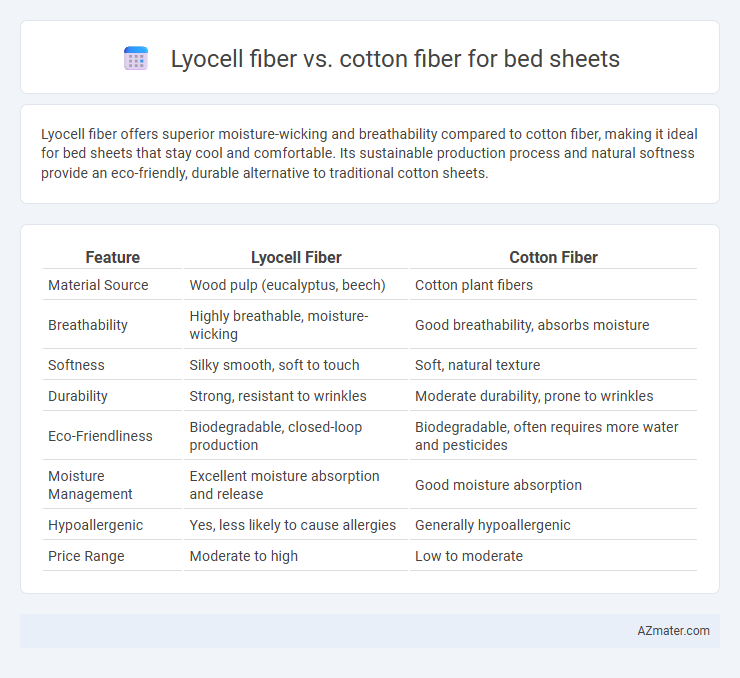Lyocell fiber offers superior moisture-wicking and breathability compared to cotton fiber, making it ideal for bed sheets that stay cool and comfortable. Its sustainable production process and natural softness provide an eco-friendly, durable alternative to traditional cotton sheets.
Table of Comparison
| Feature | Lyocell Fiber | Cotton Fiber |
|---|---|---|
| Material Source | Wood pulp (eucalyptus, beech) | Cotton plant fibers |
| Breathability | Highly breathable, moisture-wicking | Good breathability, absorbs moisture |
| Softness | Silky smooth, soft to touch | Soft, natural texture |
| Durability | Strong, resistant to wrinkles | Moderate durability, prone to wrinkles |
| Eco-Friendliness | Biodegradable, closed-loop production | Biodegradable, often requires more water and pesticides |
| Moisture Management | Excellent moisture absorption and release | Good moisture absorption |
| Hypoallergenic | Yes, less likely to cause allergies | Generally hypoallergenic |
| Price Range | Moderate to high | Low to moderate |
Introduction to Lyocell and Cotton Fibers
Lyocell fiber, derived from sustainably sourced wood pulp, is known for its softness, breathability, and moisture-wicking properties, making it an eco-friendly choice for bed sheets. Cotton fiber, harvested from the cotton plant, offers natural durability, breathability, and a soft texture that has been a traditional favorite in bedding for centuries. Both fibers provide comfort and breathability, but Lyocell's regenerative production process and superior moisture management set it apart from conventional cotton.
Origin and Production Processes
Lyocell fiber is derived from sustainably harvested eucalyptus trees through a closed-loop production process that recycles water and solvents, minimizing environmental impact. Cotton fiber originates from the cotton plant, grown predominantly in regions like the United States, India, and China, and involves extensive water usage and mechanical harvesting followed by ginning. The Lyocell production process emphasizes eco-friendliness and biodegradability, whereas cotton production requires more agricultural inputs and often involves chemical treatments.
Environmental Impact and Sustainability
Lyocell fiber, derived from sustainably harvested eucalyptus trees, offers a closed-loop production process that recycles water and solvents, significantly reducing environmental pollution compared to conventional cotton farming, which demands large amounts of water, pesticides, and land. Lyocell's biodegradable properties and lower carbon footprint enhance its sustainability for bed sheets, whereas cotton cultivation often contributes to soil degradation and high pesticide use. Choosing lyocell over cotton for bedding supports eco-friendly practices by conserving natural resources and minimizing chemical inputs.
Softness and Comfort Comparison
Lyocell fiber offers superior softness compared to cotton fiber due to its smooth, fine cellulose structure that feels gentle against the skin. The moisture-wicking and breathable properties of Lyocell enhance comfort by regulating temperature and reducing dampness, making it ideal for bed sheets. In contrast, cotton fibers, while breathable, may retain more moisture and feel rougher over time, impacting overall sleep comfort.
Breathability and Moisture Management
Lyocell fibers exhibit superior breathability compared to cotton, allowing air to circulate more freely and maintaining a cooler sleeping environment. Their moisture management capabilities efficiently wick sweat away from the skin, promoting faster evaporation and enhanced dryness throughout the night. Cotton fibers absorb moisture but tend to retain it, which can result in a damp feeling and reduced comfort during sleep.
Durability and Longevity
Lyocell fiber offers superior durability and longevity compared to cotton fiber due to its stronger molecular structure and high resistance to wear and tear. The moisture-wicking properties of Lyocell reduce fiber swelling and degradation over time, contributing to extended bed sheet lifespan. Cotton, while soft, tends to weaken faster with repeated washing, leading to faster thinning and reduced durability.
Allergenicity and Skin Friendliness
Lyocell fiber demonstrates superior skin friendliness and lower allergenicity compared to cotton, making it ideal for sensitive skin and allergy sufferers. Its smooth, hypoallergenic surface resists dust mites and bacteria better than natural cotton, reducing the risk of skin irritation and allergic reactions. Lyocell's moisture-wicking properties maintain a dry sleeping environment, further enhancing comfort and skin health.
Maintenance and Care Requirements
Lyocell fiber bed sheets require less intensive maintenance due to their natural resistance to wrinkles, moisture, and bacteria, making them ideal for easy-care routines. Cotton fiber sheets, while breathable and soft, demand more frequent washing and careful handling to prevent shrinkage and preserve fiber integrity. Both fibers benefit from gentle washing cycles and low heat drying, but lyocell's durability often reduces overall care time and effort.
Cost and Affordability
Lyocell fiber bed sheets generally have a higher initial cost compared to cotton due to the advanced manufacturing process and sustainable sourcing involved. Cotton sheets tend to be more affordable and widely available, making them a popular choice for budget-conscious consumers. However, Lyocell offers better durability and moisture-wicking properties, potentially providing longer-term value despite the higher upfront price.
Conclusion: Which Fiber is Best for Bed Sheets?
Lyocell fiber offers superior moisture-wicking, breathability, and eco-friendly production compared to cotton fiber, making it ideal for hot sleepers and sensitive skin. Cotton bed sheets provide durability, softness, and widespread availability, especially in long-staple varieties like Egyptian or Pima cotton. For optimal comfort and sustainability, Lyocell is best suited for those seeking temperature regulation and environmental benefits, while cotton remains a reliable choice for traditional softness and resilience.

Infographic: Lyocell fiber vs Cotton fiber for Bed sheet
 azmater.com
azmater.com